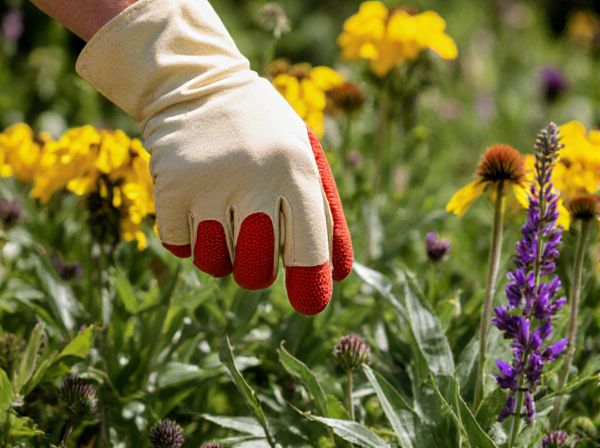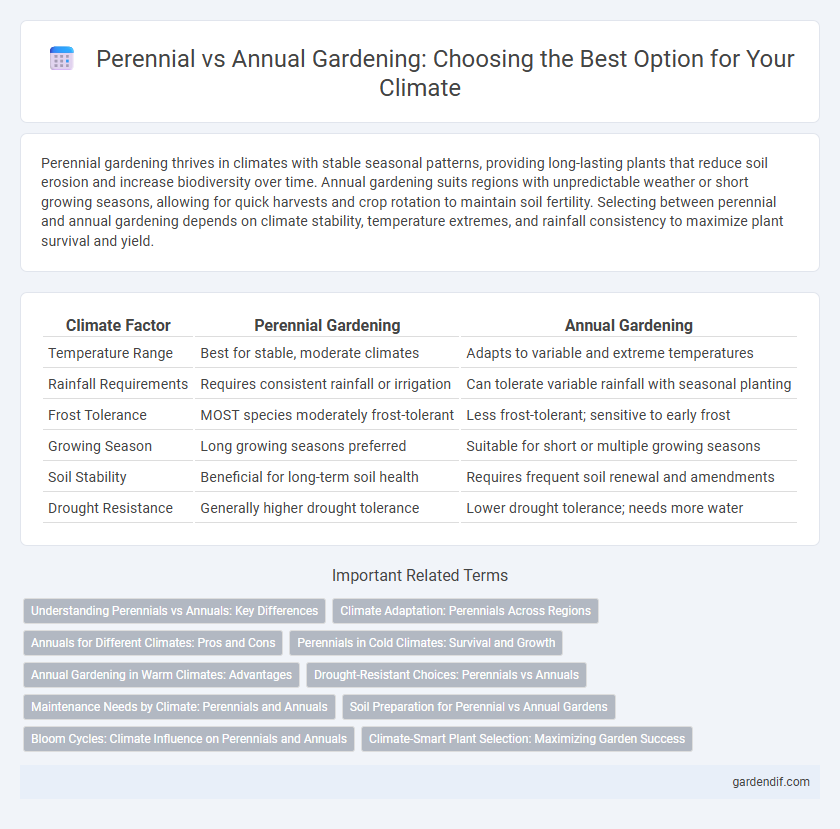
Perennial Gardening vs Annual Gardening (by climate suitability) Illustration
Perennial gardening thrives in climates with stable seasonal patterns, providing long-lasting plants that reduce soil erosion and increase biodiversity over time. Annual gardening suits regions with unpredictable weather or short growing seasons, allowing for quick harvests and crop rotation to maintain soil fertility. Selecting between perennial and annual gardening depends on climate stability, temperature extremes, and rainfall consistency to maximize plant survival and yield.
Table of Comparison
| Climate Factor | Perennial Gardening | Annual Gardening |
|---|---|---|
| Temperature Range | Best for stable, moderate climates | Adapts to variable and extreme temperatures |
| Rainfall Requirements | Requires consistent rainfall or irrigation | Can tolerate variable rainfall with seasonal planting |
| Frost Tolerance | MOST species moderately frost-tolerant | Less frost-tolerant; sensitive to early frost |
| Growing Season | Long growing seasons preferred | Suitable for short or multiple growing seasons |
| Soil Stability | Beneficial for long-term soil health | Requires frequent soil renewal and amendments |
| Drought Resistance | Generally higher drought tolerance | Lower drought tolerance; needs more water |
Understanding Perennials vs Annuals: Key Differences
Perennial gardening thrives in climates with distinct growing seasons, as perennials regrow year after year, adapting to local weather patterns and requiring less replanting effort. Annual gardening suits regions with shorter growing seasons or unpredictable frost dates, since annual plants complete their life cycle in one growing season and often provide vibrant, seasonal blooms. Understanding these differences helps gardeners select the appropriate plant type based on climate stability, soil conditions, and maintenance preferences.
Climate Adaptation: Perennials Across Regions
Perennial gardening offers superior climate adaptation by establishing deep root systems that improve resilience to temperature extremes and irregular rainfall across diverse regions. These plants contribute to soil stabilization and water retention, enhancing garden sustainability in both arid and humid climates. In contrast, annual gardening often requires more frequent replanting and irrigation, making it less efficient for long-term climate resilience.
Annuals for Different Climates: Pros and Cons
Annual gardening offers versatility across diverse climates, thriving in regions with short growing seasons or extreme temperature fluctuations. Its rapid growth cycle allows gardeners in colder or unpredictable climates to maximize bloom periods and adjust planting schedules annually. However, this approach demands more frequent soil preparation and replanting, potentially increasing labor and resource use compared to perennial gardening.
Perennials in Cold Climates: Survival and Growth
Perennial gardening in cold climates thrives due to plants' ability to survive harsh winters through deep root systems and natural dormancy mechanisms. Cold-hardy perennials such as sedum, hostas, and daylilies adapt well, requiring less replanting and maintenance compared to annuals. These plants contribute to soil stability and extend the growing season, making them ideal for regions with long, cold winters and short summers.
Annual Gardening in Warm Climates: Advantages
Annual gardening thrives in warm climates due to the extended growing seasons and consistent temperatures that support multiple crop cycles per year. This method allows gardeners to select heat-tolerant varieties, maximizing yield and diversity in fruits and vegetables such as tomatoes, peppers, and beans. The flexibility of annual gardening in warm climates also enables quick crop rotation, reducing soil depletion and pest buildup while optimizing soil health.
Drought-Resistant Choices: Perennials vs Annuals
Perennial gardening offers superior drought resistance as deep root systems enable water absorption from lower soil layers, making them better suited for arid and semi-arid climates. Annuals require frequent watering and are less resilient during prolonged dry spells, limiting their viability in drought-prone regions. Selecting native drought-tolerant perennials like lavender, sedum, or yarrow enhances water conservation efforts and reduces irrigation needs compared to annual varieties.
Maintenance Needs by Climate: Perennials and Annuals
Perennial gardening requires lower maintenance in stable climates due to plants' deep root systems and natural resilience to seasonal variations, reducing watering and soil amendment frequency. Annual gardening demands higher maintenance in extreme climates, as plants complete their life cycle within a single season, necessitating regular replanting and protection from temperature fluctuations. Selecting perennials suited to local USDA hardiness zones minimizes upkeep, while annuals need climate-specific planning to ensure growth success.
Soil Preparation for Perennial vs Annual Gardens
Soil preparation for perennial gardens requires a deeper amendment process focusing on long-term soil health with organic matter and mulching to support root systems over multiple seasons. Annual gardens demand more frequent soil tilling and nutrient replenishment since plants complete their lifecycle within one season, depleting soil nutrients rapidly. Climate factors such as temperature and precipitation influence the timing and intensity of soil preparation methods to optimize plant growth and soil sustainability.
Bloom Cycles: Climate Influence on Perennials and Annuals
Perennial gardening benefits from stable climates where plants can undergo natural bloom cycles, often flowering multiple times annually or once during specific seasons due to suitable temperature and rainfall patterns. Annual gardening adapts better to regions with short growing seasons or variable climates, as these plants complete their entire life cycle--from germination to seed production--within a single year. Climate influences the timing and duration of blooms; perennials thrive in temperate zones with consistent seasonal cues, while annuals excel in climates where rapid growth and reproduction are essential before adverse conditions.
Climate-Smart Plant Selection: Maximizing Garden Success
Perennial gardening thrives in stable climates with moderate temperature fluctuations, enabling deep root systems that improve soil health and water retention. Annual gardening suits regions with harsh winters or unpredictable weather, allowing seasonal crop rotation to optimize resource use and reduce pest buildup. Selecting climate-smart plants based on local temperature, precipitation, and growing season length enhances garden resilience and productivity.
Perennial Gardening vs Annual Gardening (by climate suitability) Infographic

 gardendif.com
gardendif.com